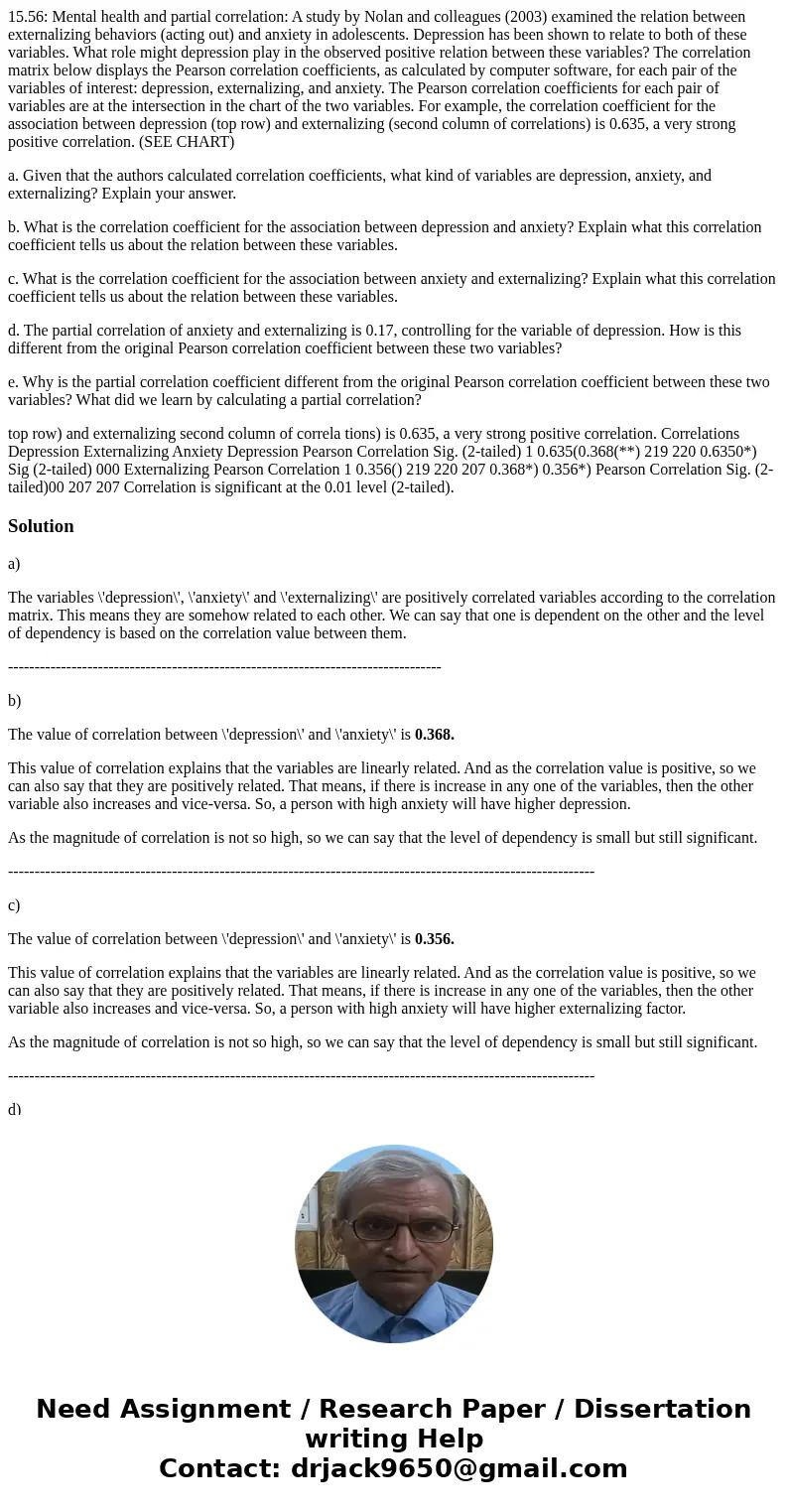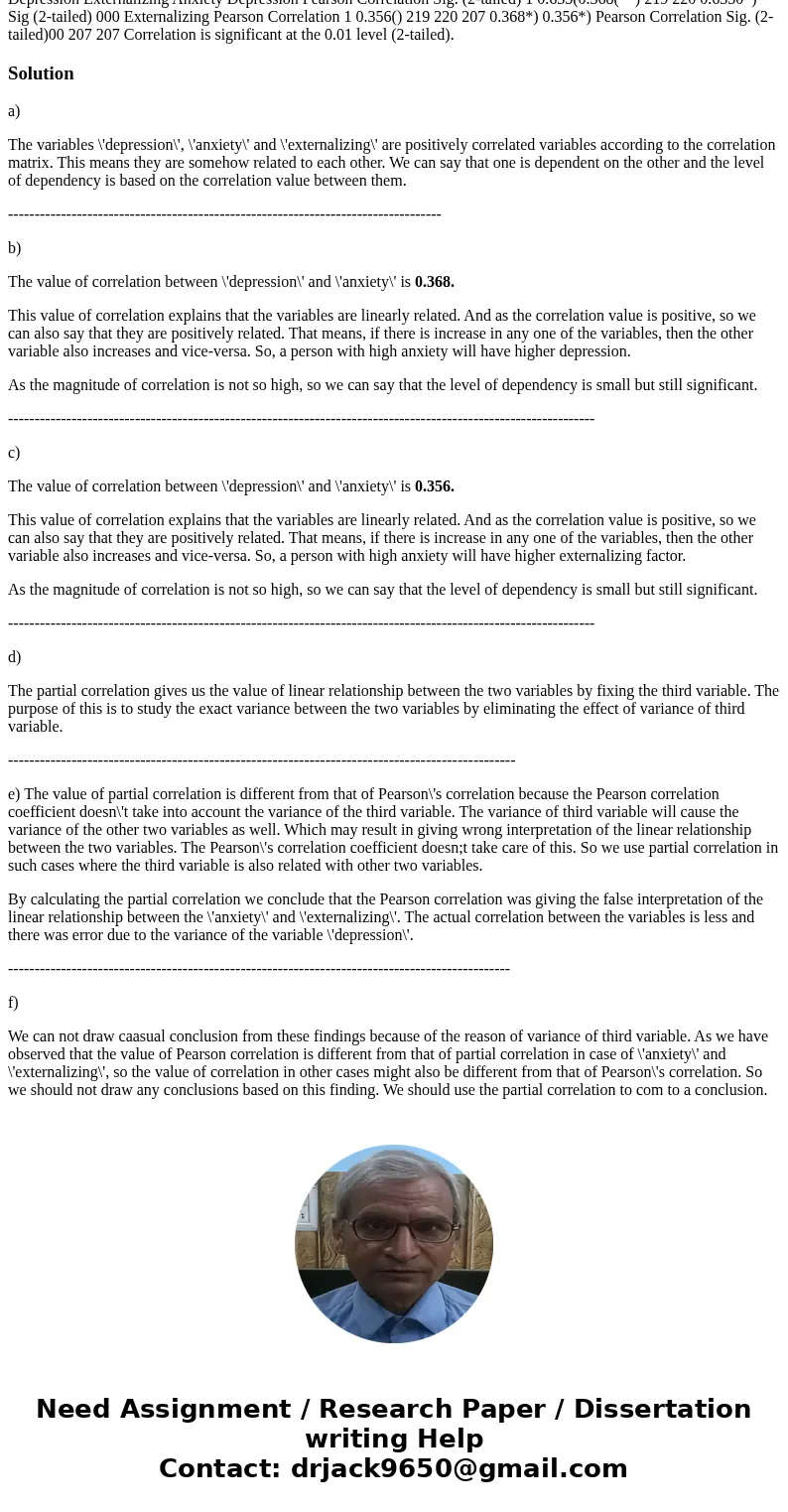1556 Mental health and partial correlation A study by Nolan
15.56: Mental health and partial correlation: A study by Nolan and colleagues (2003) examined the relation between externalizing behaviors (acting out) and anxiety in adolescents. Depression has been shown to relate to both of these variables. What role might depression play in the observed positive relation between these variables? The correlation matrix below displays the Pearson correlation coefficients, as calculated by computer software, for each pair of the variables of interest: depression, externalizing, and anxiety. The Pearson correlation coefficients for each pair of variables are at the intersection in the chart of the two variables. For example, the correlation coefficient for the association between depression (top row) and externalizing (second column of correlations) is 0.635, a very strong positive correlation. (SEE CHART)
a. Given that the authors calculated correlation coefficients, what kind of variables are depression, anxiety, and externalizing? Explain your answer.
b. What is the correlation coefficient for the association between depression and anxiety? Explain what this correlation coefficient tells us about the relation between these variables.
c. What is the correlation coefficient for the association between anxiety and externalizing? Explain what this correlation coefficient tells us about the relation between these variables.
d. The partial correlation of anxiety and externalizing is 0.17, controlling for the variable of depression. How is this different from the original Pearson correlation coefficient between these two variables?
e. Why is the partial correlation coefficient different from the original Pearson correlation coefficient between these two variables? What did we learn by calculating a partial correlation?
top row) and externalizing second column of correla tions) is 0.635, a very strong positive correlation. Correlations Depression Externalizing Anxiety Depression Pearson Correlation Sig. (2-tailed) 1 0.635(0.368(**) 219 220 0.6350*) Sig (2-tailed) 000 Externalizing Pearson Correlation 1 0.356() 219 220 207 0.368*) 0.356*) Pearson Correlation Sig. (2-tailed)00 207 207 Correlation is significant at the 0.01 level (2-tailed).Solution
a)
The variables \'depression\', \'anxiety\' and \'externalizing\' are positively correlated variables according to the correlation matrix. This means they are somehow related to each other. We can say that one is dependent on the other and the level of dependency is based on the correlation value between them.
----------------------------------------------------------------------------------
b)
The value of correlation between \'depression\' and \'anxiety\' is 0.368.
This value of correlation explains that the variables are linearly related. And as the correlation value is positive, so we can also say that they are positively related. That means, if there is increase in any one of the variables, then the other variable also increases and vice-versa. So, a person with high anxiety will have higher depression.
As the magnitude of correlation is not so high, so we can say that the level of dependency is small but still significant.
---------------------------------------------------------------------------------------------------------------
c)
The value of correlation between \'depression\' and \'anxiety\' is 0.356.
This value of correlation explains that the variables are linearly related. And as the correlation value is positive, so we can also say that they are positively related. That means, if there is increase in any one of the variables, then the other variable also increases and vice-versa. So, a person with high anxiety will have higher externalizing factor.
As the magnitude of correlation is not so high, so we can say that the level of dependency is small but still significant.
---------------------------------------------------------------------------------------------------------------
d)
The partial correlation gives us the value of linear relationship between the two variables by fixing the third variable. The purpose of this is to study the exact variance between the two variables by eliminating the effect of variance of third variable.
------------------------------------------------------------------------------------------------
e) The value of partial correlation is different from that of Pearson\'s correlation because the Pearson correlation coefficient doesn\'t take into account the variance of the third variable. The variance of third variable will cause the variance of the other two variables as well. Which may result in giving wrong interpretation of the linear relationship between the two variables. The Pearson\'s correlation coefficient doesn;t take care of this. So we use partial correlation in such cases where the third variable is also related with other two variables.
By calculating the partial correlation we conclude that the Pearson correlation was giving the false interpretation of the linear relationship between the \'anxiety\' and \'externalizing\'. The actual correlation between the variables is less and there was error due to the variance of the variable \'depression\'.
-----------------------------------------------------------------------------------------------
f)
We can not draw caasual conclusion from these findings because of the reason of variance of third variable. As we have observed that the value of Pearson correlation is different from that of partial correlation in case of \'anxiety\' and \'externalizing\', so the value of correlation in other cases might also be different from that of Pearson\'s correlation. So we should not draw any conclusions based on this finding. We should use the partial correlation to com to a conclusion.


 Homework Sourse
Homework Sourse